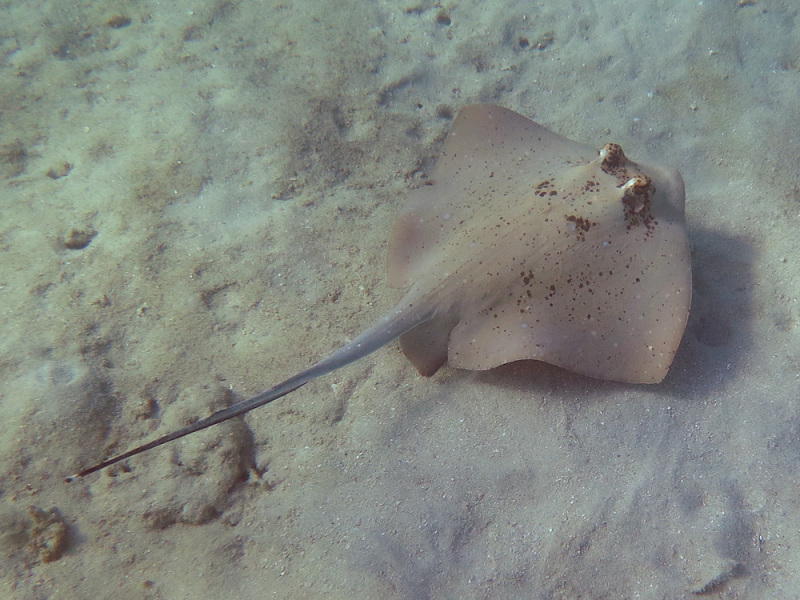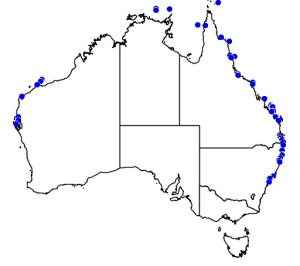�
�

©Anne Hoggett: New Caledonian Maskray at Lizard Island buried in sand with only eyes and tail tip exposed
�
���
Neotrygon trigonoides
New Caledonian Maskray

©Anne Hoggett: New Caledonian Maskray at Lizard Island buried in sand with only eyes and tail tip exposed
Kingdom
Animalia
Phylum
Chordata
Class
Elasmobranchii
Order
Myliobatiformes
Family
Dasyatidae
Genus
Neotrygon
Species
Neotrygon trigonoides
Colours
Distinguishing features
A olive-brown stingray with pale blue spots and finer black flecks on the back. The wings taper to a point and the tail has a series of white bars on its terminal end, which is often clearly visible when the ray is buried under the sand.
Size
- Up to 70 cm (Length of specimen)
Depth range
- Depth range data is not yet available.
Synonyms
Similar taxa
-
Animalia:
species: Neotrygon kuhlii
is now thought to be restricted to the Indian Ocean and Coral Triangle (Borsa et al, 2013). Prior to this, it was thought to be the common blue-spotted maskray on the Great Barrier Reef so there are many records of that name on the GBR.
Comments
There are many records of this species from the Great Barrier Reef under the name Dasyatis kuhlii. Borsa et al (2013) found that the correct name for Coral Sea specimens is Neotrygon trigonoides.
by Anne Hoggett
Distribution
Distribution and habitat preferences
Areas of sand close to reef margins.
Can be seen in most locations where sandy bottoms lie adjacent to reefs.
Behaviour
Active both diurnally and nocturnally, although more usually at night and late afternoon. Feeds on invertebrates from the sand and digs actively when hunting.
Web resources
Danger
- unspecified - The tail has a poisonous spine about half way along its length, which can be used to inflict a painful stabbing wound if the ray is stepped upon. Walk with care in shallow water on reef flats, and stand still if a stingray is near - they will always move away if given the chance.
References
References that assist with identification
- Borsa, P., I.S. Arlyza, W.-J. Chen, J.-D. Durand, M.G. Meekan and K.N. Shen (2013). Resurrection of New Caledonian maskray Neotrygon trigonoides (Myliobatoidei: Dasyatidae) from synonymy with N. kuhlii , based on cytochrome-oxidase I gene sequences and spotting patterns. Comptes Rendus Biologies, 336: 221-232. LIRS catalog number 1651.
Other references
- Gleeson, R.J and R.D. Adlard (2012). Phylogenetic relationships amongst Chloromyxum Mingazzini, 1890 (Myxozoa: Myxosporea), and the description of six novel species from Australian elasmobranchs. Parasitology International,, 61: 267-274. LIRS catalog number 1603.
- Grutter, A.S. (1997). Effect of the removal of cleaner fish on the abundance and species composition of reef fish, Oecologia, 111: 137-143. LIRS catalog number 504.
- View all references





